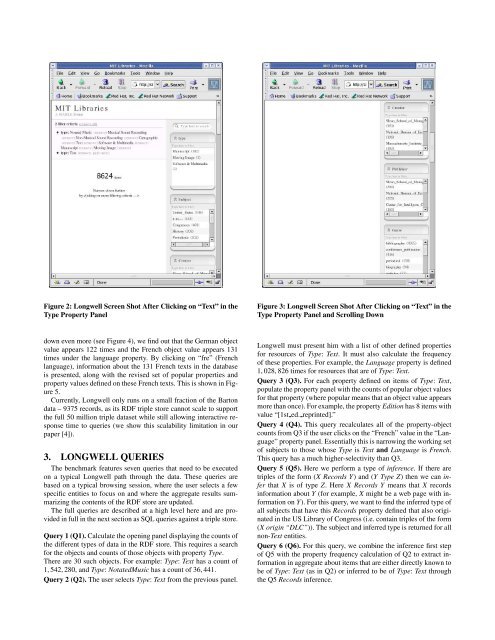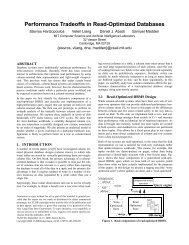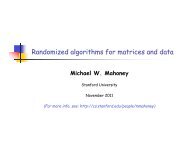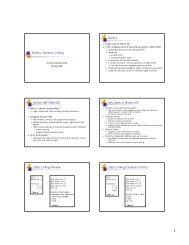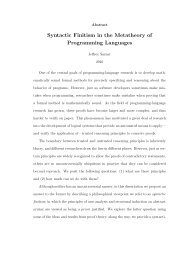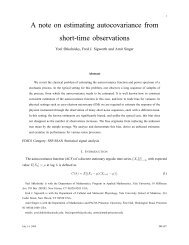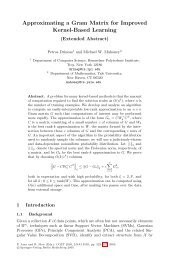Using The Barton Libraries Dataset As An RDF benchmark
Using The Barton Libraries Dataset As An RDF benchmark
Using The Barton Libraries Dataset As An RDF benchmark
You also want an ePaper? Increase the reach of your titles
YUMPU automatically turns print PDFs into web optimized ePapers that Google loves.
Figure 2: Longwell Screen Shot After Clicking on “Text” in the<br />
Type Property Panel<br />
down even more (see Figure 4), we find out that the German object<br />
value appears 122 times and the French object value appears 131<br />
times under the language property. By clicking on “fre” (French<br />
language), information about the 131 French texts in the database<br />
is presented, along with the revised set of popular properties and<br />
property values defined on these French texts. This is shown in Figure<br />
5.<br />
Currently, Longwell only runs on a small fraction of the <strong>Barton</strong><br />
data – 9375 records, as its <strong>RDF</strong> triple store cannot scale to support<br />
the full 50 million triple dataset while still allowing interactive response<br />
time to queries (we show this scalability limitation in our<br />
paper [4]).<br />
3. LONGWELL QUERIES<br />
<strong>The</strong> <strong>benchmark</strong> features seven queries that need to be executed<br />
on a typical Longwell path through the data. <strong>The</strong>se queries are<br />
based on a typical browsing session, where the user selects a few<br />
specific entities to focus on and where the aggregate results summarizing<br />
the contents of the <strong>RDF</strong> store are updated.<br />
<strong>The</strong> full queries are described at a high level here and are provided<br />
in full in the next section as SQL queries against a triple store.<br />
Query 1 (Q1). Calculate the opening panel displaying the counts of<br />
the different types of data in the <strong>RDF</strong> store. This requires a search<br />
for the objects and counts of those objects with property Type.<br />
<strong>The</strong>re are 30 such objects. For example: Type: Text has a count of<br />
1, 542, 280, and Type: NotatedMusic has a count of 36, 441.<br />
Query 2 (Q2). <strong>The</strong> user selects Type: Text from the previous panel.<br />
Figure 3: Longwell Screen Shot After Clicking on “Text” in the<br />
Type Property Panel and Scrolling Down<br />
Longwell must present him with a list of other defined properties<br />
for resources of Type: Text. It must also calculate the frequency<br />
of these properties. For example, the Language property is defined<br />
1, 028, 826 times for resources that are of Type: Text.<br />
Query 3 (Q3). For each property defined on items of Type: Text,<br />
populate the property panel with the counts of popular object values<br />
for that property (where popular means that an object value appears<br />
more than once). For example, the property Edition has 8 items with<br />
value “[1st ed. reprinted].”<br />
Query 4 (Q4). This query recalculates all of the property-object<br />
counts from Q3 if the user clicks on the “French” value in the “Language”<br />
property panel. Essentially this is narrowing the working set<br />
of subjects to those whose Type is Text and Language is French.<br />
This query has a much higher-selectivity than Q3.<br />
Query 5 (Q5). Here we perform a type of inference. If there are<br />
triples of the form (X Records Y) and (Y Type Z) then we can infer<br />
that X is of type Z. Here X Records Y means that X records<br />
information about Y (for example, X might be a web page with information<br />
on Y). For this query, we want to find the inferred type of<br />
all subjects that have this Records property defined that also originated<br />
in the US Library of Congress (i.e. contain triples of the form<br />
(X origin “DLC”)). <strong>The</strong> subject and inferred type is returned for all<br />
non-Text entities.<br />
Query 6 (Q6). For this query, we combine the inference first step<br />
of Q5 with the property frequency calculation of Q2 to extract information<br />
in aggregate about items that are either directly known to<br />
be of Type: Text (as in Q2) or inferred to be of Type: Text through<br />
the Q5 Records inference.


